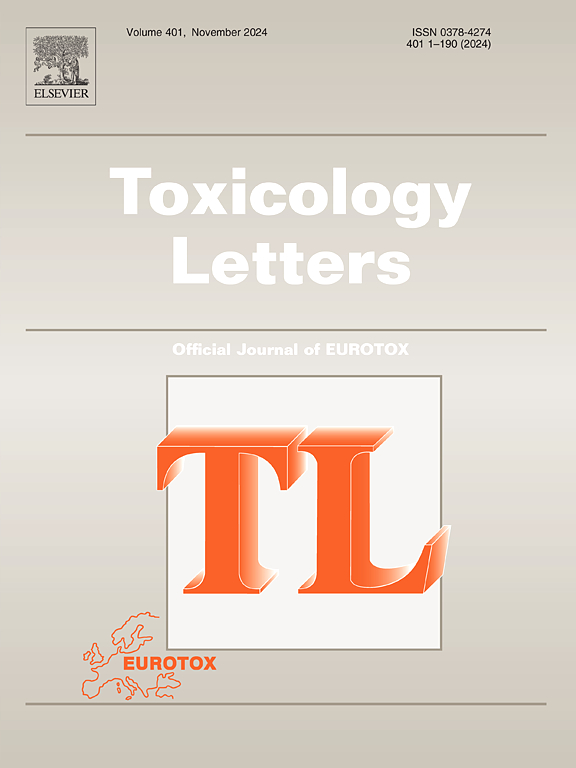Studies on acute dermal toxicity and dermal absorption of a nanoform zinc oxide (ZnO; NM-111) in rats
IF 2.9
3区 医学
Q2 TOXICOLOGY
引用次数: 0
Abstract
In two studies, the dermal toxicity (limit test following OECD TG 402) and toxicokinetics (with [65Zn]-tagged ZnO following OECD TG 427) of a nanostructured ZnO particle were characterized. The overall aim was to assess the risk of its systemic availability. Wistar rats were dermally treated once with 2000 mg ZnO/kg b.w. (limit test). – Male rats were treated topically with 2 mg/cm2 65ZnO for 6 h. Necropsy was done after the end of the exposure period (6 h) and after 24 and 72 h to investigate dermal absorption of 65ZnO. ZnO showed no clinical signs of toxicity in the limit test. – 65ZnO was not significantly absorbed following deposition: In the group means, 62–76 % of the dose applied were recovered in the not absorbed fraction. The amount of 65ZnO in the stratum corneum was found to be approx. 15 %, 8 % and 4.6 % after 6, 24 and 72 h, respectively. The 65ZnO content in the remaining skin at the application site (viable skin + remaining stratum corneum) accounted for approx. 10 %, 16 % and 16 % after 6, 24 and 72 h (total on/in the skin 25 %, 24 % and 20.6 % after 6, 24 and 72 h). No relevant radioactivity was found in faeces, urine, cage wash, organ or tissue samples.
The acute dermal limit test with ZnO resulted in ‘Unclassified’ (globally harmonized system). – Radioactivity, representative of 65ZnO, was not detected systemically after dermal application. Overall, the results indicate that 65ZnO was not absorbed with subsequent translocation beyond the skin into the blood compartment.
纳米氧化锌(ZnO)的急性皮肤毒性和皮肤吸收研究NM-111)
在两项研究中,表征了纳米结构ZnO颗粒的皮肤毒性(OECD TG 402的极限试验)和毒性动力学(OECD TG 427的[65Zn]标记ZnO)。总体目标是评估其系统性可用性的风险。Wistar大鼠皮肤注射2000 mg ZnO/kg b.w 1次(极限试验)。-雄性大鼠外用2 mg/cm2 65ZnO处理6 h。暴露期结束(6 h)、24和72 h后进行尸检,观察皮肤对65ZnO的吸收情况。在极限试验中,氧化锌未出现临床毒性症状。- 65ZnO在沉积后无明显吸收:在组均值中,施加剂量的62-76 %在未吸收部分中被回收。角质层中65ZnO的含量约为。6、24和72 h后分别为15 %、8 %和4.6 %。施用部位剩余皮肤(活皮+剩余角质层)中65ZnO含量约占。6、24和72 h后分别为10 %、16 %和16 %(6、24和72 h后皮肤上/皮肤上的总含量分别为25 %、24 %和20.6 %)。在粪便、尿液、笼子清洗、器官或组织样本中均未发现相关放射性物质。氧化锌急性皮肤极限试验结果为“未分类”(全球统一系统)。-放射性,代表65ZnO,皮肤应用后未检测到全身。总的来说,结果表明65ZnO没有被吸收,随后转运到皮肤以外的血室。
本文章由计算机程序翻译,如有差异,请以英文原文为准。
求助全文
约1分钟内获得全文
求助全文
来源期刊

Toxicology letters
医学-毒理学
CiteScore
7.10
自引率
2.90%
发文量
897
审稿时长
33 days
期刊介绍:
An international journal for the rapid publication of novel reports on a range of aspects of toxicology, especially mechanisms of toxicity.
 求助内容:
求助内容: 应助结果提醒方式:
应助结果提醒方式:


